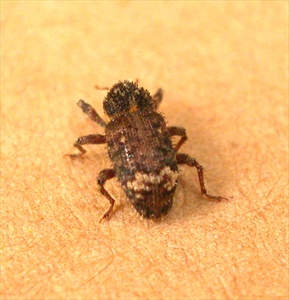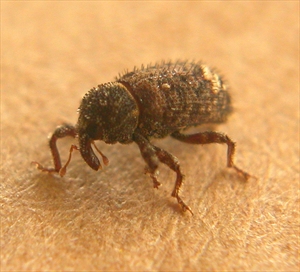- Widespread distribution. Central and South America, Caribbean, parts of US and Asia. An important pest.
- Adults lay eggs in base of stem ('crown') and in storage roots, and larvae do the damage by making tunnels. Same damage as sweetpotato weevil (Cylas).
- Does not fly; crawls from weedy borders.
- Spreads in cuttings and storage roots, same as Cylas.
- Cultural control: early, deep rooting varieties; plant only tip cuttings; remove wild morning glory; hill-up, covering cracks during dry times; ideally, make one-time harvest; 3-4-year crop rotation; after harvest, collect and destroy vines and infested storage roots.
- Chemical control: treat vines (bifenthrin); treat plants in field every 3-4 weeks (bifenthrin or fipronil).
Pacific Pests, Pathogens and Weeds - Online edition
Pacific Pests, Pathogens, Weeds & Pesticides
Sweetpotato West Indian weevil (119)
West Indian sweetpotato weevil
Euscepes batatae; previously Euscepes postfasciatus
AUTHOR Grahame Jackson
Information from CABI (2014) Euscepes postfasciatus (West Indian sweet potato weevil). Invasive Species Compendium (https://www.cabi.org/isc/datasheet/23541); and 1Reid C (2010) Identification of sweetpotato weevil species in the west Pacific. Australian Museum. Sydney; and Brookes D, et al. (2019) Origins, divergence, and contrasrting invasion history of the sweet potato weevil pests Cylas formicarius (Coleoptera: Brenttidae) and Euscepes batatae (Coleoptera: curculionidae) in the Asia-Pacific. Journal of Economic Entomology XX(XX): 1-9. https://www.researchgate.net/publication/334747037_Origins_Divergence_and_Contrasting_Invasion_History_of_the_Sweet_Potato_Weevil_Pests_Cylas_formicarius_Coleoptera_Brentidae_and_Euscepes_batatae_Coleoptera_Curculionidae_in_the_Asia-Pacific); and from O'Sullivan J et al. (undated) Sweetpotato DiagNotes: A diagnostic key and information tool for sweetpotato problems. (https://keys.lucidcentral.org/keys/sweetpotato/key/Sweetpotato%20Diagnotes/Media/Html/FrontPage/FrontPage.htm); Photos 1&2 Gerald McCormack, Cook Islands Biodiversity & Natural Heritage. (http://cookislands.bishopmuseum.org/).
Produced with support from the Australian Centre for International Agricultural Research under project PC/2010/090: Strengthening integrated crop management research in the Pacific Islands in support of sustainable intensification of high-value crop production, implemented by the University of Queensland and the Secretariat of the Pacific Community.





